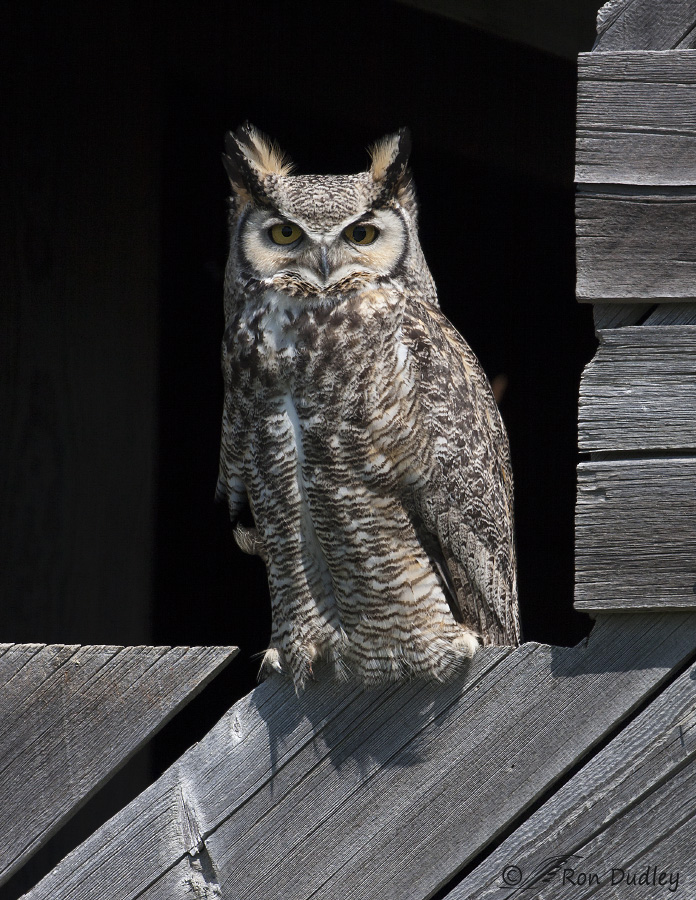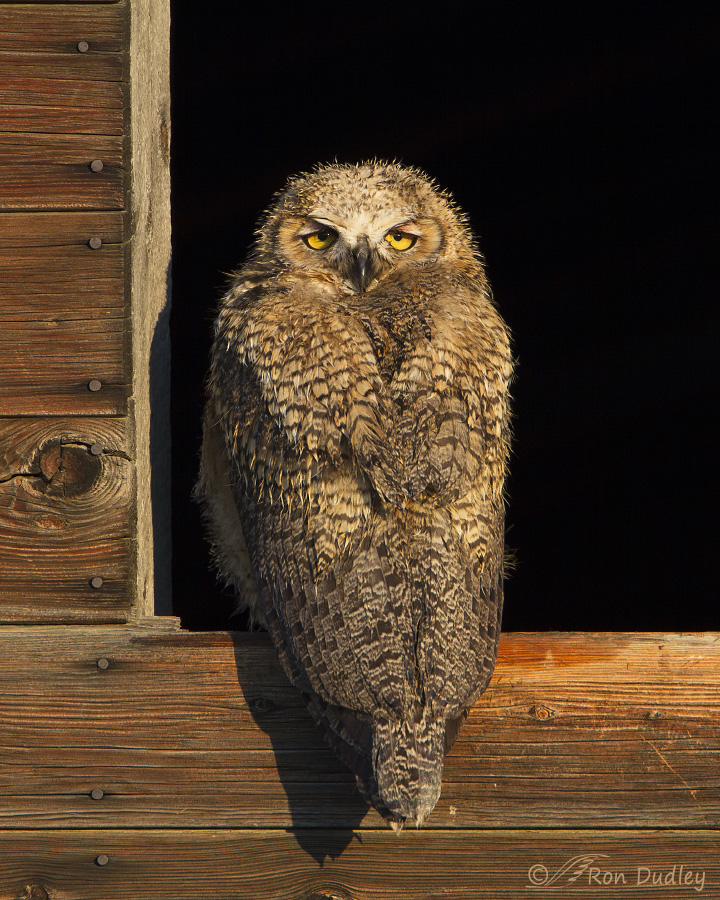I first posted these two images about 5 1/2 years ago on Feathered Photography’s 6th post ever. I’m presenting them again for the following reasons:
- they were posted long ago and I had very few followers back then so many of today’s readers have never seen them.
- when I first began blogging I was posting images at only 720 pixels on the long side. These versions are significantly larger and can be better appreciated.
- these two photos are excellent examples of a of a photographic principle I’d like to demonstrate with today’s post – the dramatic differences between warm and cool light.
Both of these Great Horned Owl images were taken on the Montana farm where I grew up as the birds were resting in the auger cutouts of old granaries built by my grandfather, uncle and father back in the early 1930’s. Those granaries haven’t been used or maintained for decades but they’re part of our family history and we’re all very fond of them, as are the owls who have lived in them for many years.
 1/2000, f/8, ISO 500, Canon 40D, Canon EF 500mm f/4L IS USM + 1.4 tc, not baited, set up or called in
1/2000, f/8, ISO 500, Canon 40D, Canon EF 500mm f/4L IS USM + 1.4 tc, not baited, set up or called in
This is one of the adult GHO’s that has raised chicks in those granaries for about 20 years that I know of (they have a life span of up to 28 years). This image was taken in late May at 2:25 PM so the sun is high and the light is harsh and cool. The wood appears gray and the warm colors of the bird are washed out by the bright light and the high angle of the sun. I’m not saying that’s necessarily all bad (I do like the photo) but that kind of light definitely affects the image.
Notice that with the sun high in the sky there’s no light in the eyes. Their bright color is the only thing that saves the day – if the eyes of this species were dark (like the pupils) they would be photon traps that would appear only as black pits.
Also notice the difference in pupil size – the left one is more than twice as large as the right one. That surprised me because the left side of the owl is the brightest so it would seem logical that the left pupil would be the smallest. It does seem slightly misshapen so maybe it’s a “blown” eye.

1/250, f/7.1, ISO 250, Canon 7D, Canon EF 500mm f/4L IS USM + 1.4 tc, not baited, set up or called in
This is a juvenile Great Horned Owl and one of the offspring of the adult in the first image. At this stage the young birds haven’t yet developed their “horns” (ear tufts). The “spikiness” of its head is partially due to the fact that it is wet from morning dew.
The image was taken at 6:07 AM, exactly 1/2 hour after sunrise, so the light on the bird and the old wood is very warm. The colors of the wood in both granaries are almost exactly the same in similar light but if you scroll between the two images you’ll see just how dramatically different those colors can be in varying light.
This last photo has always been one of my favorite Great Horned Owl images and the warm light is a big part of the reason why.
Ron
Notes:
- Whenever I see one of these photos that shows the nails in the granaries I always wonder who hammered them in – my grandfather, my uncle or my father (dad would have been a young teenager at the time).
- Some may wonder how I knew exactly when the sun rose on June 23, 2010 (the date the second image was taken). Google is amazing. All you have to do is type in a sentence like this – “When did the sun rise on June 23, 2010 in Cut Bank, Montana” as your search term and Google comes up with the answer. Maybe I’m easily impressed…


Both are very nice but, I’m with you, the juvenile is spectacular due to the light.
Both shots are wonderful but the sun angle on the juvenile makes the shot exquisite!
I agree, Nancy – the light makes the shot. Thanks.
Both images are great shots, no doubt. And who doesn’t love early morning light and what it contributes to a photo? As for, “Google is amazing”, I had to smile because there are times I use it in the course of my job. I provide technical service support for computed tomography scanners and there are times a field service engineer will call for help concerning a computer problem that if I don’t find what I need in our documentation I “Google” it and am able to provide an answer. It’s certainly a tool I don’t ignore.
Dave, I use Google very often but when I did this search I figured that the best I’d find is another website that might (or might not) provide the answer to my question. I was pleasantly surprised when the answer popped up in a box as soon as I clicked to search.
These are treasures! Love the expressions of both juvenile and adult,,,especially love the colors and textures of feathers and old wood, against the dark of the empty space behind them…the half mast eyes squinting into the sun and the hint of fuzzy feet in the first. This series brings back some powerful memories– a much appreciated gift….thank you!
I wish I had at least one of Wol’s feathers….
Thanks, Patty. Owls and old wood – for me they’re a perfect match.
Exquisite shots Ron (yes, my standing WOW appears again!)!
I’ve always loved the light at sunrise and sundown. I generally fly the birds in the late afternoon, and I particularly loved that with Mariah, the redtail. The late afternoon sunlight makes her reds just POP and it’s simply glorious! The downside is I struggle to do my brush-beating job while gawking, open-mouthed at the sheer overwhelming splendor!
I love your “standing WOW”, Laura. Thank you.
Great shots, Ron and a wonderful demonstration of how the light affects the photos. I generally have to deal with them in trees and the light/shadow that entails. The young are always amusing to watch. The bird does appear to have mismatched eyes in the first photo. The old wood does look dramatically different depending on the light – I’ve noted that here. At the moment our current pair have come in and are “talking”. Thx for posting them
I generally have to deal with them in trees and the light/shadow that entails. The young are always amusing to watch. The bird does appear to have mismatched eyes in the first photo. The old wood does look dramatically different depending on the light – I’ve noted that here. At the moment our current pair have come in and are “talking”. Thx for posting them
Judy, that’s one thing I’m lucky about when I shoot these owls. I don’t have to worry about shadows from branches and leaves!
Juvenile – Yeh, so don’t you know its cold out here and all Dad is doing is looking big and bold! humph! I need food to keep me warm!!
Wonderful images Ron, I love the colors and the markings!
Yes, it was cold, Dick – even that time of year in early mornings up there.
Wow! The chick is drop dead beautiful. Pure art. Thank you for sharing it.
Thanks very much, Richard.
Ron – both are great pix as usual But the difference is dramatic as you so helpfully pointed out. Thanks for these helpful tips. I now realize why photographers need to get out early in the day or at dusk. thanks.
Yup, the quality of the light can make a huge difference, Mark.
The juvenile GHO image is one of my all-time favorite Ron Dudley captures–the lighting is lovely, and the expression on the bird’s face is priceless. Thanks for sharing again
I feel the same way about that image, Christine!
Wonderful shots Ron!
Charlotte
Thanks, Charlotte.